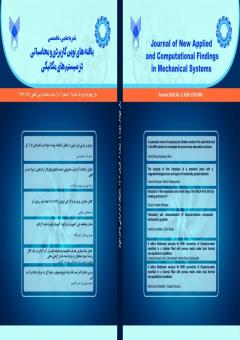کاهش جدایش جریان و درگ کلی ایرفویل ناکا 4415 با ایجاد شیار بر روی آن
محورهای موضوعی : یافته های نوین کاربردی و محاسباتی در سیستم های مکانیکی
1 - هیئت علمی دانشگاه امام علی(ع)
کلید واژه: ایرفویل ناکا 4415, افزایش راندمان ایرفویل, تغییر هندسی ایرفویل, تاثیر شیار, کاهش جدایش جریان ,
چکیده مقاله :
ایرفویلها با توجه به هندسه خاص خود طوری طراحی شدهاند تا بتوانند بهصورت بهینه نیروی لیفت ایجاد کنند و کارایی سازههای هوایی یا دریایی را بهبود بخشند. علاوه بر طراحیهای استاندارد و رایج ایرفویلها در صنایع مختلف، میتوان برای افزایش بهرهوری آنها را نیز بهینهسازی نمود. در این پژوهش، نیروی لیفت تولید شده توسط ایرفویلهای شیاردار NACA 4415 که در هواپیماها، پهپادها و توربینهای بادی کاربرد دارند، مورد بررسی قرارگرفته است. با استفاده از روش طراحی آزمایش فاکتوریل کامل، تأثیر تعداد و عمق شیارها بر نیروی لیفت در زوایای حمله مختلف و در یک عدد رینولدز ثابت ارزیابی شده است. نتایج نشان میدهد که شیارها در برخی از زوایا منجر به افزایش چشمگیر نیروی لیفت شدهاند. به طوری که در زاویه حمله 13 درجه افزودن شیار به سطح ایرفویل میتواند نیروی لیفت را تا 31% افزایش دهد.
Lift force is essential in the movement of bodies in fluid environments, as it enables aerodynamic objects to shift perpendicularly to the direction of their motion. Airfoils are specifically designed with unique geometries to efficiently generate lift force, enhancing the performance of aerial or marine structures. Despite the use of standardized and widely adopted airfoil designs across various industries, further optimizations are still possible to increase efficiency. In this study, the lift force generated by slotted NACA 4415 airfoils, commonly used in aircraft, UAVs, and wind turbines, is examined. Using a full factorial experimental design, the effects of slot number and depth on lift force at various angles of attack and at a constant Reynolds number were evaluated. The results indicate that slots have minimal impact on lift force at certain angles of attack, while leading to significant increases at others. For example, at an angle of attack of 13 degrees, adding slots to the airfoil surface can increase lift force by up to 31%.
[1] R. E. Xu, "Numerical Simulation of Flow Over Airfoil and Its Optimization," Journal of Physics: Conference Series, vol. 2441, no. 1, p. 012004, 2023.
[2] A. Ghoddoussi, "A conceptual study of airfoil performance enhancements using CFD," AIAA Atmospheric Flight Mechanics Conference, p. 4655, 2011.
[3] J. Ye, "Effects of Micro-Tab on the Lift Enhancement of Airfoil S-809 with Trailing-Edge Flap," Processes, vol. 9, no. 3, p. 547, 2021.
https://doi.org/10.3390/pr9030547 [4] M. R. A. Nabawy, "The role of the leading edge vortex in lift augmentation of steadily revolving wings: a change in perspective," J R Soc Interface, vol. 14, no. 132, p. 20170159, 2017 .
https://doi.org/10.1098%2Frsif.2017.0159 [5] T. Liu, "Evolutionary understanding of airfoil lift," Advances in Aerodynamics, vol. 3, no. 37, 2021. https://doi.org/10.1186/s42774-021-00089-4
[6] T. WU, "Lift performance enhancement for flapping airfoils by considering surging motion," Chinese Journal of Aeronautics, vol. 35, no. 9, pp. 194-207, 2022. https://doi.org/10.1016/j.cja.2021.11.015
[7] A. D. Paranjape, "Computational analysis of high-lift-generating airfoils for diffuser-augmented wind turbines," Wind Energy Science Conference, vol. 6, no. 1, p. 149–157, 2021. https://doi.org/10.5194/wes-6-149-2021
[8] C. Themistokleous, "A High-Lift Optimization Methodology for the Design of Leading and Trailing Edges on Morphing Wings," Appl. Sci., vol. 11, no. 6, p. 2822, 2021. https://doi.org/10.3390/app11062822
[9] P. Fz-Retana-Amescua, "Numerical study of high lift devices to improve airfoil aerodynamic performance," Energy Sources Part A-recovery Utilization and Environmental Effects, vol. 44, no. 4, pp. 9135-9155, 2022. https://www.doi.org/10.1080/15567036.2022.2129879
[10] P. Dosi, "Multi-objective Optimization of Aerofoil," Advances in Industrial and Production Engineering, pp. 801-811, 2021. https://www.doi.org/10.1007/978-981-33-4320-7_71
[11] Z. Wang, "Lift Enhancement of a Flat-Plate Airfoil by Steady Suction," AIAA Journal, vol. 55, no. 4, pp. 1355-1372, 2017. https://www.doi.org/10.2514/1.J055382
[12] M. A. Aziz, "Combined droop nose and trailing-edges morphing effects on airfoils aerodynamics," SN Applied Sciences, vol. 1, no. 9, pp. 1-14, 2019. https://www.doi.org/10.1007/S42452-019-0796-6
[13] M. Desalvo, "High-lift enhancement using active flow control," 6th AIAA flow control conference, p. 3245, 2012. https://www.doi.org/10.2514/6.2011-3355
[14] M. DeSalvo, "Enhancement of a high-lift airfoil using low-power fluidic actuators," 5th Flow Control Conference, p. 4248, 2010. https://www.doi.org/10.2514/6.2010-4248
[15] Z. Lei, "Lift enhancement of supersonic thin airfoil at low speed by co-flow jet active flow control," AIAA aviation 2021 forum, p. 2591, 2021. https://www.doi.org/10.2514/6.2021-2591
[16] Y. Yang, "Super-lift coefficient of active flow control airfoil: What is the limit?," 55th AIAA Aerospace Sciences Meeting, p. 1693, 2017. https://www.doi.org/10.2514/6.2017-1693
[17] Z. Wang, "Post-stall lift enhancement of a flat plate airfoil by suction," 53rd AIAA Aerospace Sciences Meeting, p. 1269, 2015. https://www.doi.org/10.2514/6.2015-1269
[18] V. I. Kornilov, "Effect of air blowing and suction through single slots on the aerodynamic performances of an airfoil," Journal of Applied Mechanics and Technical Physics, vol. 60, pp. 871-881, 2019. https://www.doi.org/10.1134/S0021894419050109


